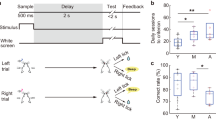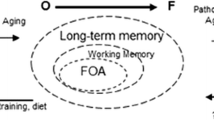Abstract
Cognitive functions, such as memory, attention, and perception, decline with age. Besides other neuroanatomical changes, the level of dopamine also attenuates during aging. We review how computational modeling can provide insights in how these lifetime changes in dopamine levels are expressed at the behavioral level yielding a bridge across different levels. Results indicate that attenuation of dopamine lowers the signal to noise ratio providing a less distinctive neural representation, and detrimental cognitive performance.
Access this chapter
Tax calculation will be finalised at checkout
Purchases are for personal use only
Preview
Unable to display preview. Download preview PDF.
Similar content being viewed by others
References
Arnsten AFT (1998) Catecholamine modulation of prefrontal cortical cognitive function. Trends Cogn Sci 2: 436–447
Arnsten AFT, Cai JX, Murphy BL, Goldmanrakic PS (1994) Dopamine D1 receptor mechanisms in the cognitive performance of young adult and aged monkeys. Psychopharmacology 116: 143–151
Band GPH, Kok A (2000) Age effects on response monitoring in a mental-rotation task. Biol Psychol 51: 201–221
Braver TS (1997) Mechanisms of cognitive control: a neurocomputational model. Psychological Department, Carnegie Mellon University, Pittsburgh
Braver TS, Barch DM (2002) A theory of cognitive control, aging cognition, and neuromodulation. Neurosci Biobehav Rev 26: 809–817
Braver TS, Cohen JD (2001) Working memory, cognitive control, and the prefrontal cortex: computational and empirical studies. Cogn Process 2: 25–55
Bäckman L, Ginovart N, Dixon RA, Robins Wahlin T-B, Wahlin Å, Halldin C, Farde L (2000) Age-related cognitive deficits mediated by changes in the striatal dopamine system. Am J Psychiatry 157: 635–637
Cabeza R (2002) Hemispheric asymmetry reduction in older adults: the Harold model. Psychol Aging 17: 85–100
Cass WA, Gerhardt GA (1995) In vivo assessment of dopamine uptake in rat medial prefrontal cortex: comparison with dorsal striatum and nucleus accumbens. J Neurochemistry 65: 201–207
Cohen JD, Dunba K, McClelland JL (1990) On the control of automatic processes: a parallel distributed processing model of the Stroop effect. Psychol Rev 97: 332–361
Cohen JD, Servan-Schreiber D (1992) Context, cortex, and dopamine: a connectionist approach to behavior and biology in Schizophrenia. Psychol Rev 99: 45–77
Collins JJ, Imhoff P, Grigg P (1996) Noise-enhanced tactile sensation. Nature 383: 770
Craik FIM (1983) On the transfer of information from temporary to permanent memory. Philos Trans R Soc Lond B 302: 341–359
Craik FIM, Salthouse TA (2000) The handbook of aging and cognition. NJ, Erlbaum
de Keyser J, Debacker JP, Vauquelin G, Ebinger G (1990) The effect of aging on the D1 dopamine receptors in the human cortex. Brain Res 528: 308–310
Durstewitz D, Seamans JK (2002) The computational role of dopamine D1 receptors in working memory. Neural Netw 15: 561–572
Erixon-Lindroth N, Farde L, Robins-Wahlin T-B, Sovago J, Halldin C, Bäckman L (2005) The role of the striatal dopamine transporter in cognitive aging. Psychiatry Res 138: 1–1
Ferrandez AM, Teasdale N (1996) Changes in sensory motor behavior in aging. New York, Elsevier Science
Fry AF, Hale S (2000) Relationship among processing speed, working memory, and fluid intelligens in children. Biol Psychol 54: 1–34
Gehring WJ, Goss B, Coles MGH, Meyer DE, Donchin E (1993) A neural system for error detection and compensation. Psychol Sci 4: 385–390
Giorgi O, Calderini G, Toffano G, Biggio G (1987) D1 dopamine receptors labeled with 3H-SCH 23390: decrease in the striatum of aged rats. Neurobiol Aging 8: 51–54
Hasher L, Zacks RT (1988) Working memory, comprehension and aging: a review and a new view. The psychology of learning and motivation. G. H. Bower. New York, Academic Press 22: 193–225
Holroyd CB, Coles MGH (2002) The neural basis of human error processing: reinforcement learning, dopamine, and the error-related negativity. Psychol Rev 109: 679–709
Kassinen V, Vilkman H, Hietala J, Nagren K, Helenius H, Olsson H, Farde L, Rinne JO (2000) Age-related dopamine D2/D3 receptor loss in extrastriatal regions of the human brain. Neurobiol Aging 21: 683–688
Li S, Lindenberger U, Sikström S (2001) Aging Cognition: from neuromodulation to representation to cognition. Trends Cogn Sci 5: 479–486
Li S-C, Lindenberger U, Frensch PA (2000) Unifying cognitive aging: from neuromodulation to representation to cognition. Neurocomputing 32–33: 879–890
Li S-C, Sikström S (2002) Integrative neurocomputational perspectives on cognitive aging, neuromodulation, and representation. Neurosci Biobehav Rev 26: 795–808
Li S-C, von Oertzen T, Lindenberger U (in press) A neurocomputationtional model of stochastic resonance and aging
Liu W, Lipsitz LA, Montero-Odasso M, Bean J, Kerrigan DC, Collins JJ (2002) Noise-enhanced vibrotactile sensitivity in older adults, patients with stroke, and patients with diabetic neuropathology. Arch Phys Med Rehabil 83: 171–176
MacRae PG, Spirduso WW, Wilcox RE (1988) Reaction time and nigrostriatal dopamine function: the effect of age and practice. Brain Res 451: 139–146
Murphy BL, Arnsten AFT, GoldmanRakic PS, Roth RH (1996) Increased dopamine levels turnover in the prefrontal cortext impairs spatical working memory performance in rats and monkeys. Proc Natl Acad Sci USA 93: 1325–1329
Nieuwenhuis S, Ridderinkhof KR, Talsma D, Coles MGH, Holroyd CB, Kok A, Van der Molen MW (2002) A computational account of altered error processing in older age: dopamine and the error-related negativity. Cogn Affect Behav Neurosci 2: 19–36
Nilsson LG, Bäckman L, Erngrund K, Nyberg L, Adolfsson R, Bucht G, Karlsson S, Widing G, Winblad B (1997) The Betula prospective cohort study: memory, health, and aging. Aging Neuropsych Cogn 4: 1–32
Park DC, Lautenschlager G, Hedden T, Davison N, Smith AD, Smith PK (2002) Models of visuospatial and verbal memory across the adult life span. Psychol Aging 17: 299–320
Schultz W (1998) Predictive reward signal of dopamine neurons. J Neurosci Neurophysiol 80: 1–27
Seamans JK, Floresco SB, Phillips AG (1998) D1 receptor modulation of hippocampal-prefrontal cortical circuits integrating spatial memory with executive functions in the rat. J Neurosci 18: 1613–1621
Servan-Schreiber D, Printz H, Cohen J (1990) A network model of catecholamine effects: gain, signal-to-noise ratio, and behavior. Science 249: 892–895
Sikström S (2004) The variance reaction time model. Cogn Psychol 48: 371–421
Simonotto E, Riani M, Seife C, Roberts M, Twitty JD, Moss F (1997) Visual perception of stochastic resonance. Phys Rev Lett 78: 1186–1189
Simonotto E, Spano F, Riani M, Ferrari A, Levriero F, Pilot A, Renzetti P, Paodi R, Sardanelli F, Vitali P, Twitty J, Chiou-Tan F, Moss F (1999) fMRI studies of visual cortical activity during noise timulation. Neurocomputing 26–27: 511–516
Spengler F, Godde B, Dinse HR (1995) Effects on aging on topographic organization of somatosensory cortex. NeuroReport 6: 469–473
Stevens CF, Cruz LA, Marks LE, Lakatos S (1998) A multimodal assessment of sensory threshold in aging. J Gerontol 53B: 263–272
Sutton RS, Barto AG (1998) Reinforcement learning: an introduction. MIT Press, Cambridge, MA
Thimm G, Moerland P, Fiesler E (1996) The interchangeability of learning rate and gain in backpropagation neural networks. Neural computation 8: 451–460
Watanabe M, Kodama T, Hikosaka K (1997) Increase of extracellular dopamine in primate prefrontal cortex during a working memory task. J Neurophysiol 78: 2795–2798
Wells C, Ward LM, Chua R, Inglis JT (2005) Touch noise increases vibrotactile sensitivity in old and young. Psy Sci 16: 313–320
West RL (1996) An application of prefrontal cortex function theory to cognitive aging. Psychol Bull 120: 272–292
Wong DF, Young D, Wilson PD, Meltzer CC, Gjedde A (1997) Quantification of neuroreceptors in the living brain: III. D2-like dopamine receptors: theory, validation and changes during normal aging. J Cerebr Blood Flow Metab 17: 316–330
Zelinski EM, Stewart ST (1998) Individual differences in 16-year memory changes. Psychol Aging 13: 622–630
Author information
Authors and Affiliations
Corresponding author
Editor information
Editors and Affiliations
Rights and permissions
Copyright information
© 2007 Springer-Verlag
About this chapter
Cite this chapter
Sikström, S. (2007). Computational perspectives on neuromodulation of aging. In: Sakas, D.E., Simpson, B.A. (eds) Operative Neuromodulation. Acta Neurochirurgica Supplements, vol 97/2. Springer, Vienna. https://doi.org/10.1007/978-3-211-33081-4_59
Download citation
DOI: https://doi.org/10.1007/978-3-211-33081-4_59
Publisher Name: Springer, Vienna
Print ISBN: 978-3-211-33080-7
Online ISBN: 978-3-211-33081-4
eBook Packages: MedicineMedicine (R0)




